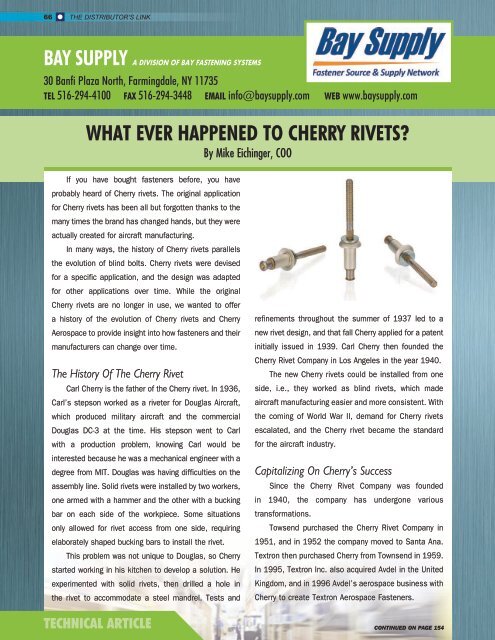FALL 2023
Distributor's Link Magazine Fall 2023 / Vol 46 No 4
Distributor's Link Magazine Fall 2023 / Vol 46 No 4
Create successful ePaper yourself
Turn your PDF publications into a flip-book with our unique Google optimized e-Paper software.
66<br />
THE DISTRIBUTOR’S LINK<br />
BAY SUPPLY A DIVISION OF BAY FASTENING SYSTEMS<br />
30 Banfi Plaza North, Farmingdale, NY 11735<br />
TEL 516-294-4100 FAX 516-294-3448 EMAIL info@baysupply.com WEB www.baysupply.com<br />
WHAT EVER HAPPENED TO CHERRY RIVETS?<br />
By Mike Eichinger, COO<br />
If you have bought fasteners before, you have<br />
probably heard of Cherry rivets. The original application<br />
for Cherry rivets has been all but forgotten thanks to the<br />
many times the brand has changed hands, but they were<br />
actually created for aircraft manufacturing.<br />
In many ways, the history of Cherry rivets parallels<br />
the evolution of blind bolts. Cherry rivets were devised<br />
for a specific application, and the design was adapted<br />
for other applications over time. While the original<br />
Cherry rivets are no longer in use, we wanted to offer<br />
a history of the evolution of Cherry rivets and Cherry<br />
Aerospace to provide insight into how fasteners and their<br />
manufacturers can change over time.<br />
The History Of The Cherry Rivet<br />
Carl Cherry is the father of the Cherry rivet. In 1936,<br />
Carl’s stepson worked as a riveter for Douglas Aircraft,<br />
which produced military aircraft and the commercial<br />
Douglas DC-3 at the time. His stepson went to Carl<br />
with a production problem, knowing Carl would be<br />
interested because he was a mechanical engineer with a<br />
degree from MIT. Douglas was having difficulties on the<br />
assembly line. Solid rivets were installed by two workers,<br />
one armed with a hammer and the other with a bucking<br />
bar on each side of the workpiece. Some situations<br />
only allowed for rivet access from one side, requiring<br />
elaborately shaped bucking bars to install the rivet.<br />
This problem was not unique to Douglas, so Cherry<br />
started working in his kitchen to develop a solution. He<br />
experimented with solid rivets, then drilled a hole in<br />
the rivet to accommodate a steel mandrel. Tests and<br />
refinements throughout the summer of 1937 led to a<br />
new rivet design, and that fall Cherry applied for a patent<br />
initially issued in 1939. Carl Cherry then founded the<br />
Cherry Rivet Company in Los Angeles in the year 1940.<br />
The new Cherry rivets could be installed from one<br />
side, i.e., they worked as blind rivets, which made<br />
aircraft manufacturing easier and more consistent. With<br />
the coming of World War II, demand for Cherry rivets<br />
escalated, and the Cherry rivet became the standard<br />
for the aircraft industry.<br />
Capitalizing On Cherry’s Success<br />
Since the Cherry Rivet Company was founded<br />
in 1940, the company has undergone various<br />
transformations.<br />
Towsend purchased the Cherry Rivet Company in<br />
1951, and in 1952 the company moved to Santa Ana.<br />
Textron then purchased Cherry from Townsend in 1959.<br />
In 1995, Textron Inc. also acquired Avdel in the United<br />
Kingdom, and in 1996 Avdel’s aerospace business with<br />
Cherry to create Textron Aerospace Fasteners.<br />
TECHNICAL ARTICLE CONTINUED ON PAGE 154
















